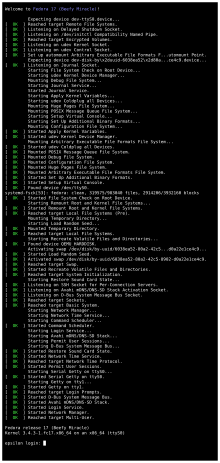 systemd startup on Fedora 17 | |
| Original author(s) | Lennart Poettering[1] |
|---|---|
| Developer(s) | Red Hat (Lennart Poettering, Kay Sievers, Harald Hoyer, Daniel Mack, Tom Gundersen, David Herrmann);[2] 345 different authors in 2018[3] and 2,032 different authors in total [4] |
| Initial release | 30 March 2010 |
| Stable release | 256.7[5] |
| Repository | |
| Written in | C |
| Operating system | Linux |
| Type | |
| License | LGPLv2.1+[6] |
| Website | systemd.io |
systemd is a software suite that provides an array of system components for Linux[7] operating systems. The main aim is to unify service configuration and behavior across Linux distributions.[8] Its primary component is a "system and service manager" — an init system used to bootstrap user space and manage user processes. It also provides replacements for various daemons and utilities, including device management, login management, network connection management, and event logging. The name systemd adheres to the Unix convention of naming daemons by appending the letter d.[9] It also plays on the term "System D", which refers to a person's ability to adapt quickly and improvise to solve problems.[10]
Since 2015, the majority of Linux distributions have adopted systemd, having replaced other init systems such as SysV init. It has been praised by developers and users of distributions that adopted it for providing a stable, fast out-of-the-box solution for issues that had existed in the Linux space for years.[11][12][13] At the time of adoption of systemd on most Linux distributions, it was the only software suite that offered reliable parallelism during boot as well as centralized management of processes, daemons, services and mount points.
Critics of systemd contend that it suffers from mission creep and bloat, the latter affecting other software (such as the GNOME desktop), adding dependencies on systemd, reducing its compatibility with other Unix-like operating systems and making it difficult for sysadmins to integrate alternative solutions. In addition, they contend that the complexity of systemd results in a larger attack surface, reducing the overall security of the platform.[14] Concerns have also been raised about Red Hat and its parent company IBM controlling the scene of init systems on Linux.[15][1]
- ^ a b "Lennart Poettering on systemd's Tumultuous Ascendancy". 26 January 2017. Archived from the original on 8 November 2018. Retrieved 7 November 2018.
- ^ Cite error: The named reference
READMEwas invoked but never defined (see the help page). - ^ "Systemd Hits A High Point For Number Of New Commits & Contributors During 2018 - Phoronix". Archived from the original on 21 September 2009. Retrieved 30 December 2018.
- ^ Used the "contributors" statistic from: systemd/systemd, systemd, 3 December 2023, retrieved 3 December 2023
- ^ "Release 256.7". 8 October 2024. Retrieved 27 October 2024.
- ^ Cite error: The named reference
licensewas invoked but never defined (see the help page). - ^ "Rethinking PID 1". 30 April 2010. Archived from the original on 22 February 2022. Retrieved 20 August 2021.
systemd uses many Linux-specific features, and does not limit itself to POSIX. That unlocks a lot of functionality a system that is designed for portability to other operating systems cannot provide.
- ^ "InterfaceStabilityPromise". FreeDesktop.org. Archived from the original on 11 December 2017. Retrieved 14 February 2018.
- ^ "systemd System and Service Manager". freedesktop.org. Archived from the original on 15 October 2020. Retrieved 19 March 2016.
Yes, it is written systemd, not system D or System D, or even SystemD. And it isn't system d either. Why? Because it's a system daemon, and under Unix/Linux those are in lower case, and get suffixed with a lower case d.
- ^ Cite error: The named reference
control-centerwas invoked but never defined (see the help page). - ^ "Debate/initsystem/systemd - Debian Wiki". wiki.debian.org. Archived from the original on 7 December 2014. Retrieved 15 November 2021.
- ^ "F15 one page release notes - Fedora Project Wiki". fedoraproject.org. Archived from the original on 27 September 2013. Retrieved 15 November 2021.
- ^ Gaudreault, Stéphane (14 August 2012). "Migration to systemd". arch-dev-public (Mailing list). Archived from the original on 20 October 2020. Retrieved 15 November 2021.
- ^ "Freedesktop Systemd : List of security vulnerabilities". CVE Details. Archived from the original on 3 October 2021. Retrieved 3 October 2021.
- ^ Saunders, Mike (11 November 2015). "Linux 101: Get the most out of systemd". Linux Voice. Archived from the original on 29 May 2016. Retrieved 28 January 2016.